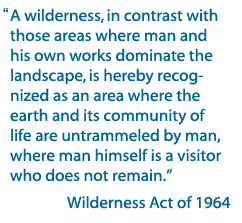In Aldo Leopold’s words, wilderness is “the very stuff America is made of.” In pressing our civilization across a wild land, our ancestors became pioneers, conquering most of  the continent’s wild places. Through that very process, our encounter with wilderness shaped in us as a people hardy pioneer characteristics we think as fundamental to our American identity -- self-reliance, fortitude, hard work, a fierce independence, an innate love of the land.
the continent’s wild places. Through that very process, our encounter with wilderness shaped in us as a people hardy pioneer characteristics we think as fundamental to our American identity -- self-reliance, fortitude, hard work, a fierce independence, an innate love of the land.
By the early part of the 20th century, the momentum of pioneering had carried us across the continent, up every mountain valley and down every canyon, threatening to wipe out all wilderness. In reaction to this loss of wilderness was born a uniquely American idea: to deliberately preserve scenic wonders and expanses of wild nature as wilderness, with a motive of not losing the imprint of frontier wildness so formative and fundamental to American values. We share an instinctive, insistent duty to pass some of that original legacy on, unmodified and untrammeled, so that those who follow may experience living wilderness.
What are Wilderness Areas?
Wilderness Areas are special places where the earth and its community of life are essentially undisturbed; they retain a primeval character, without permanent improvements and generally appear to have been affected primarily by the forces of nature. In 1964, Congress established the National Wilderness Preservation System and designated the first Wilderness Areas in passing the Wilderness Act. Wilderness preservation has become an increasingly significant tool to ensure long-term protection of natural landscapes. Note: Wilderness Areas are closed to all motorized vehicles and mechanical forms of transportation, including mountain bikes. For more information on Wilderness, see: http://www.blm.gov/nlcs/wilderness/faq.htm
What are Wilderness Study Areas?
Wilderness Study Areas (WSAs) are roadless areas that have been inventoried and found to have wilderness characteristics as described in the Federal Land Policy and Management Act (FLPMA) and the Wilderness Act of 1964. FLPMA directed the BLM to study the agency’s roadless areas and recommend those that should be designated as wilderness. The BLM inventoried the lands it manages in order to identify those with the basic wilderness characteristics described in the Wilderness Act of 1964. Public lands that had wilderness characteristics were designated as WSAs and are managed to protect these wilderness values until Congress decides the future of these areas. For more on WSAs, see: www.blm.gov/nlcs/wsa/faq.htm
Wilderness Benefits
Wilderness areas contribute significantly to our nation’s health and well-being. The benefits these areas provide are as diverse as the areas themselves and far exceed the mere acreage protected.
- Water & Air – Wilderness areas are important sources of clean water and air. While the benefits of wilderness transcend its boundaries, they are threatened by forces outside wilderness. Pollution decreases water and air quality that people, plants and animals rely on, while preserving wilderness protects clean water and air.
- Wildlife/Plant Communities – Wildlife and plant communities are protected in wilderness, from grizzly bears to wildflowers. Wilderness designations also protect natural processes, including natural disturbances like fire, which give rise to rich biodiversity. Wildlife is threatened by non-native species, pollutants, and the suppression of natural processes. Preserving wilderness preserves wildlife.
- Legacy – The legacy of wilderness is passed on from generation to generation by many who will never visit wilderness, yet value its undisturbed quality. Failure to preserve the untrammeled and natural conditions of these areas threatens this legacy.
- Recreation – Wilderness was created for the use and enjoyment of the American people. Yearly, over 12 million people visit Wilderness Areas to hike, ride horses, hunt, fish, ski, float, take pictures and stargaze, to name a few. Many people who visit wilderness are inspired and humbled by the feeling of being part of something larger than oneself. Wilderness is a haven for self discovery and rejuvenation. Visitors must be aware that high use of sensitive areas threatens the untrammeled quality of wilderness. Preserving the integrity of wilderness preserves its unique recreational value. For more information about recreation opportunities on BLM NM lands, click here.